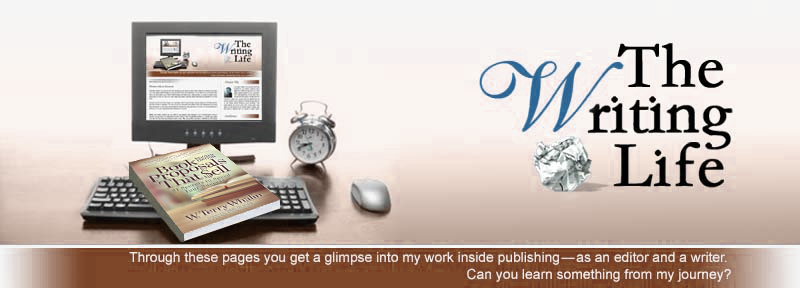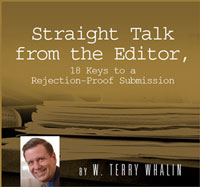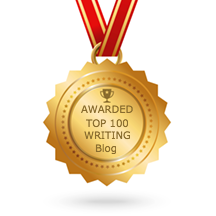How to Handle Editorial Trauma
By Terry Whalin @terrywhalin
Over the last few days, I have been in editorial trauma. It has happened to me over and over in my years in publishing. I don't like to be here but it is a reality of this business. Every writer needs an editor (or maybe a series of editors) to help you with your blindspots, raise questions where information is missing and improve what you are publishing. Whether you are writing for a traditional publisher or self-publishing, this editor is a critical partner in producing excellent work.
Months ago on deadline, I completed a book manuscript, which is one of the first books in a series from this publisher. My book will be published later this year and during those silent months, the publisher was evaluating and talking about the pattern for their series. Whenever you write one of the first books in a series of books, there will be revisions and bumps in the process. I've been working through those bumps this past week and it has not been easy work.
No matter who the publisher or editor, the process is fairly straightforward. You write your manuscript in Microsoft Word, then the editor turns on the tracking feature in Word and edits. If they have questions or need you to fix something, then the editor adds a comment into the margin which looks like a little post-it on the screen. As the writer, my role is to go through these questions and answer each one to the best of my ability. When I am asked for additional information, I add it. When something needs clarification, I clarify. It's the detailed and important work for the book to be excellent. While I understand this truth, it doesn't make the process any easier to complete successfully.
It has been months since I focused on the content for this book. The publisher eliminated some of the features (narrowed them) and added a section or two (which now I have to complete).
Several lessons for you when you are in the middle of this editorial process:
1. The editor's questions are professional and not personal. It is all about the work and producing excellent work for the reader. I've worked with this editor for years and admire his editorial skill—even if I don't like answering all of the questions—I answer them anyway and rewrite and improve my book.
2. The process is messy at times. I've had to do additional research to answer some of the questions and dig into some reference books on my shelf. I've worked long hours at my keyboard with a screen covered with questions and editorial marks.
3. It is all part of the process of making excellent books which touch lives and help readers. It does not have to be easy (because it isn't). If it were easy, everyone would do it.
4. I know I will get through this editorial trauma—eventually. As much as I've been through this process over the years, I look at some of those questions and to myself say, “Enough with all these questions.” Then I get up and take a few minutes away from my screen. I return to it and keep moving forward and making the requested changes and adjustments. The mansucript is finite and I will get through it.
5. Excellent publishing is a team sport. You can certainly design your own cover, edit your own book and self-publish. Unless you are a multi-talented person, I suspect your book will be hard to sell, receive little positive feedback and probably few sales. There are exceptions to these statements but overall we need each other to succeed. However you publish, you will have different people on your team who are experts in their part of the process.
6. I learn a great deal each time I go through this process. I've published many articles and books over the years but I am still growing as a writer and learn as I answer these questions. Months ago I worked hard on the manuscript that I turned in—but now with this additional work, it will be even better. I can absorb the lessons from the questions and improve my next manuscript.
I'm going back to my editorial work and determined to keep moving through it and answer every question to get this manuscript back to my editor. Then the book can move into copy editing, proofreading and eventually printing then distribution to the bookstores.
The reality is we don't have to like every part of the publishing process—but we do need to understand it and work our way through it to produce an excellent book. I hope this article has helped you understand it is not easy to produce excellent books but each of us with persistence (and some patience) can do it.
Have you been through this editorial trauma process? What tips and insights do you have to get through it? Let me know in the comments below.
Tweetable:
Over the last few days, I have been in editorial trauma. It has happened to me over and over in my years in publishing. I don't like to be here but it is a reality of this business. Every writer needs an editor (or maybe a series of editors) to help you with your blindspots, raise questions where information is missing and improve what you are publishing. Whether you are writing for a traditional publisher or self-publishing, this editor is a critical partner in producing excellent work.
Months ago on deadline, I completed a book manuscript, which is one of the first books in a series from this publisher. My book will be published later this year and during those silent months, the publisher was evaluating and talking about the pattern for their series. Whenever you write one of the first books in a series of books, there will be revisions and bumps in the process. I've been working through those bumps this past week and it has not been easy work.
No matter who the publisher or editor, the process is fairly straightforward. You write your manuscript in Microsoft Word, then the editor turns on the tracking feature in Word and edits. If they have questions or need you to fix something, then the editor adds a comment into the margin which looks like a little post-it on the screen. As the writer, my role is to go through these questions and answer each one to the best of my ability. When I am asked for additional information, I add it. When something needs clarification, I clarify. It's the detailed and important work for the book to be excellent. While I understand this truth, it doesn't make the process any easier to complete successfully.
It has been months since I focused on the content for this book. The publisher eliminated some of the features (narrowed them) and added a section or two (which now I have to complete).
Several lessons for you when you are in the middle of this editorial process:
1. The editor's questions are professional and not personal. It is all about the work and producing excellent work for the reader. I've worked with this editor for years and admire his editorial skill—even if I don't like answering all of the questions—I answer them anyway and rewrite and improve my book.
2. The process is messy at times. I've had to do additional research to answer some of the questions and dig into some reference books on my shelf. I've worked long hours at my keyboard with a screen covered with questions and editorial marks.
3. It is all part of the process of making excellent books which touch lives and help readers. It does not have to be easy (because it isn't). If it were easy, everyone would do it.
4. I know I will get through this editorial trauma—eventually. As much as I've been through this process over the years, I look at some of those questions and to myself say, “Enough with all these questions.” Then I get up and take a few minutes away from my screen. I return to it and keep moving forward and making the requested changes and adjustments. The mansucript is finite and I will get through it.
5. Excellent publishing is a team sport. You can certainly design your own cover, edit your own book and self-publish. Unless you are a multi-talented person, I suspect your book will be hard to sell, receive little positive feedback and probably few sales. There are exceptions to these statements but overall we need each other to succeed. However you publish, you will have different people on your team who are experts in their part of the process.
6. I learn a great deal each time I go through this process. I've published many articles and books over the years but I am still growing as a writer and learn as I answer these questions. Months ago I worked hard on the manuscript that I turned in—but now with this additional work, it will be even better. I can absorb the lessons from the questions and improve my next manuscript.
I'm going back to my editorial work and determined to keep moving through it and answer every question to get this manuscript back to my editor. Then the book can move into copy editing, proofreading and eventually printing then distribution to the bookstores.
The reality is we don't have to like every part of the publishing process—but we do need to understand it and work our way through it to produce an excellent book. I hope this article has helped you understand it is not easy to produce excellent books but each of us with persistence (and some patience) can do it.
Have you been through this editorial trauma process? What tips and insights do you have to get through it? Let me know in the comments below.
Tweetable:
Labels: book production rewrite, business, editor, editorial work, publisher, publishing, trauma























0 Comment:
Post a Comment
That's the writing life...
Back to the home page...